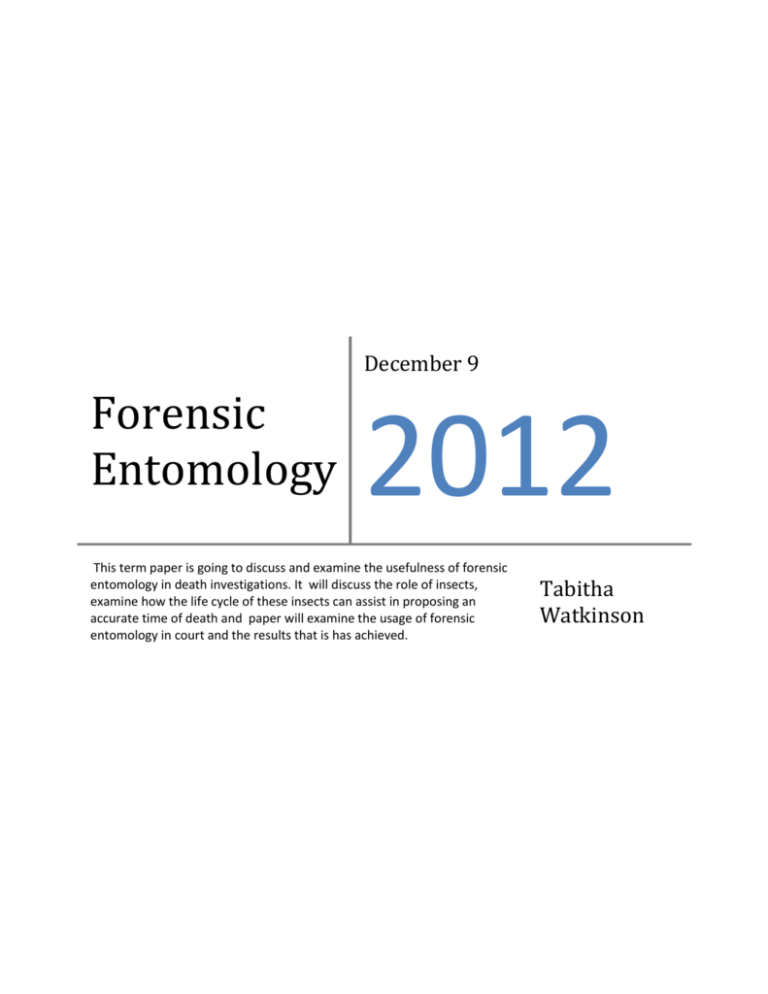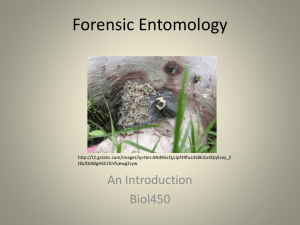Forensic Entomology
advertisement

December 9 Forensic Entomology 2012 This term paper is going to discuss and examine the usefulness of forensic entomology in death investigations. It will discuss the role of insects, examine how the life cycle of these insects can assist in proposing an accurate time of death and paper will examine the usage of forensic entomology in court and the results that is has achieved. Tabitha Watkinson Watkinson Forensic entomology is the study of insects to determine the post-mortem interval (time since death) of a decaying human corpse. The insects found in, around, and near the body are collected and examined to generate a precise time of death. Forensic entomology can be useful in situations where decomposition is too extreme for a medical examiner alone to determine time of death1. Hundreds of different insects or bugs can be drawn to a decomposing corpse, but only a few are useful in the study of forensics entomology2. The two species most instrumental to a forensic entomologist investigation are blowflies and beetles. Both species have a metamorphosis life cycle making apparent which cycle of life the insect is in. Using the current stage of the insect, in comparison to how long it takes the insect to complete that cycle, presents investigators with an accurate post-mortem interval3. In China, during the thirteenth century, we see the first documentation of forensic entomology recorded in a Medico-Legal journal. The case was reported by Chinese lawyer and death investigator, SÒNG CÍ; the case consisted of a stabbing that had taken place in a rice field. SÒNG CÍ investigated the murder the following day knowing traces of blood would still be on the murder weapon. Upon confronting all the rice field workers, he had them lay out their sickles on to the table in front of him blowflies were automatically attracted to the tool with the trace amounts of blood on it. The owner of the tool automatically confessed to the crime once questioned4. A significant legal case, which helped establish forensic entomology as a recognized tool for forensic investigation, was that of a murdered and mummified newborn. 1 (Gennard, 2007) (Benecke, 2008) 3 (Gennard, 2007) 4 (Benecke, 2008) 2 2 Watkinson In the eighteen-fifties, during renovation work taking place in a boarding house, a baby’s mummified corpse was discovered encased in the chimney. While performing the autopsy, Dr. Marcel Bergeret discovered the larvae of flesh flies and the remnants of moths. With this information Dr. Bergeret deduced the date in which the body had been sealed into the chimney based on the arrival of the moths being a year after death. With the estimation of the time of death, occupier of the boarding home prior to the current owners were accused of the murder5. During the first seventy-two hours of death, depending on conditions and fall of body temperature, a medical examiner can accurately report time of death. Once this seventy-two hour window is closed there is less medical information apparent to report time of death so a different method is needed. This is where forensic entomology comes in. Using the life cycle of a specific species of insects a forensic entomologist can deduce a post-mortem interval over a period of hours, weeks, and months. It has been established that the start of the post-mortem interval generally coincides with when a fly first laid eggs on the body. Once the body is discovered entomologist look to identify the ‘oldest colonizing’ species and its current stage. With this information and taking into account the particular stage of decay a forensic entomologist gives the best estimated time of death6. Realistically speaking, stages of decomposition don’t truly exist. Most characteristics of a stage can be mixed between more than one stage. However, stages of decomposition are categorized between five general stages. The five stages of decomposition consist of: fresh, bloated, active decay, advanced decay, and skeleton. Fresh decomposition stage usually shows initial insect colonization. During this stage there are no signs of physical change to the body. 5 6 (Gennard, 2007) (Gennard, 2007) 3 Watkinson Chemicals released during the first few minutes of death can attract blowflies and one to three hours following their arrival eggs may be laid on the body. The bloat stage consists of putrefaction and the release of fluids and gasses. During this stage maggots are active. Active decay consists of an increase in the releasing of fluids, skin marbling and slippage, and exposure of internal organs. During this stage maggot and insect activity is at its peak. By advanced decay and skeleton stage the flesh is off of the body some hair may still remain. The insects have, for the majority, migrated away from the body. Adult insects are no longer attracted to the body during these stages7. As previously stated the insects most important for examination by a forensic entomologist are the blowfly and beetle. Many other species of flies, wasps, and months are also associated with the decaying of a corps but are not as prominent as the blowfly and beetle. Because these two particular species go through a complete metamorphosis from stage to stage and look very different at each, it is easier to estimate how old the specimen is and then convert the information into an estimated post-mortem interval. Blowfly life cycles consist of egg, three larva stages, pre pupa, pupa, and adult. At a certain temperature there is a set amount of time that is known for how long it takes each of these stages to occur and the duration of each8. On fresh corpses adult blow flies start to lay eggs in the mouth, nasal openings, ears, and in wounds and bruises as early as fifteen minutes after death9.The eggs are approximate two millimeters in length and typically stay the same for the first eight hours with more noticeable 7 (Carter) (Hall, 2006) 9 (Bullington, 2008) 8 4 Watkinson changes in the following hours10. The stage typically lasts twenty-four hours and even if they don’t seem that significant, the eggs can be both identified and aged during this time. The flies then progress into their larval stage. There are three larval stages or ‘instars’ referred to as L1, L2 and L3.These instars take place over a period of one to five days. The specific larval stage can be determined by the number of splits present in each posterior spiracle. There is also a difference in larval size that can validate the larval stage L1 consisting of less than two millimeters in length and L3 being capable to progress to twenty-two millimeters long. Larvae in the third stage are the largest and stop feeding halfway through the stage and begin to migrate focusing on finding a place for pupariation 11. We begin to see this migration into prepupa stage eight to twelve days after eggs are laid. Eighteen to twenty-four days, after the prepupas gradually become a pupa, one begins to see darkness with age. The pupa becomes nine millimeters in length and begins the process of pushing out of operculum; therefore, the presence of empty operculum is an indication the entomologist that the body has been dead for at least twenty days12. A beetles metamorphism is very similar to the blow fly consisting of: egg stage, three to five larval stages and, pupal stage. The beetles holometabolous development can take anywhere from seven to ten days, or a year to three years depending on the species of beetle. All species of beetles have a similar resemblance in the egg stage, all seeming to appear oval or spheroid shape. 10 (Starkeby, 2008) (Gennard, 2007) 12 (Starkeby, 2008) 11 5 Watkinson Unlike the blowfly, the beetle buries itself into the ground or body in order to pupate. ‘Less detailed information is available about beetle life cycles than is known about the Diptera’13. Insects are cold blooded, which forces them to use their environment as a heat source; they need to utilize a particular amount of energy in order to achieve the life stages. Therefore, insect growth is influenced by the temperature of their environment. After identifying the insects found on the body, the information gathered from them would them would then need to be linked to the temperature at the crime scene. From this information, you can determine the length of time the flies took to grow from an egg to the developmental stage recovered from the body14. Forensic entomology has had judicial acceptance as evidence in courts for more than a century due to its fundamental scientific principles including insect development associated with temperature and beetles ecological behavior patterns. Insect evidence is evaluated by state / federal courts under the general rubric of scientific ‘expert testimony.’ For these reason the entomological evidence collected and presented by the expert witness must be collected, examine, and calculated precisely and properly. Samples of insects of all stages should be collected from different areas of the body, clothing, and soil. Information such as vegetation, soil type, weather and temperature time of collection, elevation and sunlight should all be recorded. Notes will also have to be made about the extent and type of clothing, if the body was covered by dirt or exposed, directionality of body, and stage of decomposition if available15. 13 (Gennard, 2007) (Gennard, 2007) 15 (Anderson) 14 6 Watkinson A forensic entomologist’s job is to provide an unbiased, objective, scientific analysis of the evidence in the court room or in their working daily endeavors. Some crimes would never have the capacity to be solved without the information gathered from entomological evidence. In early June, alongside a rural highway, the body of a young female was discovered. Following an autopsy it was determined the cause of death was multiple stab wounds inflicted by a ‘heavy-sharp object’ to the head and neck. The Jane Doe was reported missing by her brother approximately four days prior, June first, to the body being discovered. The primary suspect, a thirty- year- old army sergeant, was the last person to be seen with Ms. Jane Doe on the morning of May thirty-first. Circumstantial evidence had supported the theory that the victim had been murdered by the sergeant but an accurate estimation of time of death was crucial in establishing what events had truly transpired. The times of death presented by the medical examiners were more approximate then specific. The doctors came to their conclusions superficially. The medical examiners based their approximated time of death on the stage of decomposition the body was in but, this was not accurate enough to be used in court. This case had to be solved based solely on the entomological evidence gathered from the crime scene. Numerous insects were collected from the scene including those that were around the victims open head wound. Some larvae were collected alive, as to be able to morph into adult stage, while others were placed into liquid preservation so the developmental stage at time of collection could be discovered. Weather data, including temperatures, rainfalls, cloud cover, wind direction/speed, and humidity were gathered from the weather station located a short distance away from where the body was discovered to indicate the environmental conditions it had been exposed to. Jane Doe’s conditions when found and autopsy procedures were also looked over. All of these pieces of evidence together determined a more precise time of death. An entomologist was able to 7 Watkinson analyzes the information and confirm that the first insect colonized on the body had arrived on May thirty-first, the day the victim was last seen with the sergeant. When questioned and presented with the evidence the suspect admitted to murdering the young girl by striking her with a small hatchet six to eight times. The sergeant entered a plea of guilty to murder and received life in prison without parole16. Since World War Two, only a few scientists and crime scene investigators have established progress in the field of forensic entomology. The challenges they faced consisted of convincing authorities and fellow scientists of the benefits of using entomological evidence in criminal investigations. Today, judges all over have come to the decision that forensic entomology is suitable for usage in cases ranging from murders to wildlife violations17. The field of forensic entomology is rapidly expanding into areas that may not have been possible if it weren’t for the technology that is available today. With the advancement of new technology, entomological research can become more accurate and detailed leading to a variety of new possibilities for the field. 16 17 (Forensic Investigation Forensic Entomology, 2009) (Forensic Entomology: The Next Step, 2001) 8 Watkinson Bibliography Anderson, D. G. (n.d.). Forensic Entomology: The use of Insects in Death Investigation. Retrieved from Simon Fraser University: http://www.sfu.ca/~ganderso/forensicentomology.htm Benecke, M. (2008). A Brief Survey of the History of Forensic Entomology. Köln, Germany: International Forensic Research & Consulting. Bullington, S. W. (2008, August 3). Blow Flies: Their Life Cycle and Where to Look For The Various Stages. Retrieved from Forensic Entomology: http://users.usachoice.net/~swb/forensics/index.htm Carter, D. O. (n.d.). Human Decomposition Ecology. Retrieved from Forensic Osteology: http://forost.org/seminar/Segundo_seminario/Human_Decomposition_Ecology.pdf Forensic Entomology: The Next Step. (2001). Retrieved from Preventing Disease, Disability, and Premature Death: http://www.phsource.us/PH/ME/nextstep.pdf Forensic Investigation Forensic Entomology. (2009, March). Retrieved from The University of Western Australia: Centre for Learning Technology: http://www.clt.uwa.edu.au/__data/page/112507/fse09_case_studies.pdf Gennard, D. E. (2007). Forensic Entomology. West Sussex: John Wiley & Sons Ltd. Hall, A. B. (2006, July 26). Forensic Entomology. Retrieved September 9, 2012, from Science in Schools: http://www.scienceinschool.org/2006/issue2/forensic Starkeby, M. (2008). Forensic Entomology Overview. Retrieved from Forensic Science: http://www.cienciaforense.com/pages/entomology/overview.htm#What 9








